
19 minute read
Reverend Dom Julian Stead O.S.B. ’43
REVEREND DOM JULIAN STEAD ’43
Reverend Dom Julian Stead O.S.B.’43, monk and priest of Portsmouth Abbey and alumnus of Portsmouth Priory School, died early on the morning of Dec 23, 2020 at St. Clare-Newport where he had been in residence for the past several years.
“Father Julian knew for weeks that this day was approaching,” said Prior Michael Brunner at Father Julian’s funeral Mass on December 30, 2020. “He deeply felt the call to move on. He really wanted to return to England and to be at Downside, but God was calling him to his true home. Jesus has finally extended this invitation to an exemplary monk, priest and teacher: ‘Come, you blessed by My Father. Inherit the kingdom prepared for you from the foundation of the world’.”
Father Julian was born Peter Force Stead on 20 November 1926 in Oxford, England, of American parents who made their home in Oxford. His father, William Force Stead, had graduated from the University of Virginia in 1908, working for the United States State Department in Washington, D.C. He would serve as Vice Consul at the U.S. Consulates in Nottingham and later in Liverpool, England. William Stead left this career in 1918 to become an ordained priest in the Church of England, serving as an assistant chaplain in Florence, Italy, before returning to chaplaincy work in Oxford. He earned his Master of Arts in Theology at Queen’s College in 1925 and inhabited a heady intellectual world, notably receiving T.S. Eliot into the Anglican communion and baptizing him in 1927. Eliot later included two of the elder Stead’s poems in the 1936 edition he edited of The Oxford Book of Modern Verse 1892-1935.
In addition to T.S. Eliot, Stead counted among his associates W.B. Yeats, C.S. Lewis, and later W.H. Auden, Tennessee Williams, and many others. His vocation, however, took a definitive turn in 1933, when he converted to Catholicism, following his wife, Anne Frances Goldsborough Stead, who had become a Catholic in 1929. William soon found himself alienated from Anglican society and resigned his position at Worcester College. This rich and, one might say, tumultuous intellectual and spiritual heritage no doubt impacted the young Peter Stead profoundly. In There Shines Forth Christ, he recollects, “My early childhood was spent around Worcester College, where my father was a fellow; but at Blackfriars on St. Giles, in August of 1933, he and I were received into the Roman Catholic Church by the Dominican Father Bede Jarrett.”
Peter Stead attended Worth, the preparatory school for Downside Abbey, beginning in the summer term of 1935. He remembered his years at Worth as his happiest, writing in an autobiographical note to his poetry collection, “It was an earthly paradise, for me.” He formed a profound friendship with Dom Julian Stonor, the monk and mystic who was on the faculty there and later served heroically in World War II as chaplain to the Irish Guards, and from whom he would take his name in religion. In an interview with Miriam Matheson Desrosiers, Father Julian speaks of his father’s reaction to an initial encounter with Father Stonor: “He was proof of the existence of God himself.” Father Julian Stonor became the monastic namesake of Peter Stead, who never ceased to speak fondly, reverently, of the man as a saint. His schooling at Worth had been shaped by their encounter: “This young teacher, Julian Stonor, was most impressive. I had him as a teacher of French; we read great stories about adventure in glider planes and a great deal of poetry. He took us out for long walks and tree climbing. We called him Brother Julian and we called ourselves ‘Julian’s Gang.’” Fr. Stonor remained in touch with Father Julian, who spoke often of his sanctity. The authenticity and vitality of his faith left its imprint on the young Peter Stead, who continued to seek out such qualities in Christian community life. This may be seen in Father Julian’s involvement in the Focolare movement, whose
Father Julian on the day of his ordination
name means “hearth” and whose faith life promotes a genuine and warm hospitality. His ongoing relationship with Focolare was sustaining for him, and he would often speak highly of this Apostolic group.
For the summer holidays of 1939, Peter’s father took him to visit his grandfather and other relatives in America, sailing from Liverpool on 12 August, to return to Worth for the Michaelmas Term in September.
However, Germany invaded Poland a week before they were to return, and citizens carrying an American passport were prohibited from travelling to the theatre of war thereby preventing the Steads’ return home. An Oxford friend recommended Portsmouth Priory School, where young Peter was admitted in January 1940; he entered the monastery later in September 1943. Fr. Julian reflected on his arrival at Portsmouth in the School’s 2019 Winter Bulletin: “When I came here as a student in January 1940, there was a war on. Only ninety boys were enrolled in the school, with sixteen of us displaced from English schools. In those days, students were being prepared primarily not for college but for death.”
Upon his Portsmouth Priory graduation Peter expressed an interest in joining the monastery, and was told to get a job for a year. After working on a farm in Maryland he entered the monastic community in September of 1943. He then studied at St. Anselmo in Rome and received his S.T.L. there. He also studied at Blackfriars in Oxford where he was ordained a priest. Fr. Julian recounts those years in his book of poetry, “In April 1952 I was ordained to the Catholic priesthood in the same Dominican church while studying theology at Blackfriars as a member of St. Benet’s Hall. In between St. Giles and Walton Street is ‘The Studio,’ a mews flat on Pusey Lane, where Jean and Sheldon Vanauken lived that year. I was studying at Blackfriars, and my friendship with them and the circle of Christians who used to meet in “The Studio’ made a mark on my subsequent life.’”
In the monastery Father Julian held a multitude of jobs. He taught philosophy and patristics to the young monks. He frequently served as guest master; he was novice master from 1973 to 1983 and again from 1993 to 1995.
In the School Fr. Julian taught Christian Doctrine and Latin. He served as mentor to the Photography and Riflery Clubs and, for a time, worked in the Office of Admission. Teaching in the school was difficult for him, and he once remarked, “The only thing more boring than taking Latin I is teaching Latin I.” He loved the Fathers of the Church and taught a course in that subject at some point to some interested students. He also taught a course in patristics at Providence College from 1974 to 1976.
John Belt ’57 recollects, “Dom Julian and a few students started the Portsmouth Rifle Team in 1956. I was the captain in my Fifth and Sixth Form years (‘56 & ‘57). The range was in the basement of the gymnasium. The space for the range was an area excavated by students on detention. It took about three years to dig out a suitable area. The experience on the Portsmouth team allowed me to compete on the collegiate level at John’s Hopkins University’s ROTC Team. He was a great instructor and truly a credit to the Benedictine Order. Great memories and a wonderful man with a huge sense of humor.”
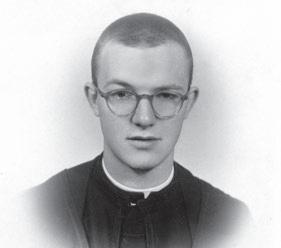
Dom Julian as a novice
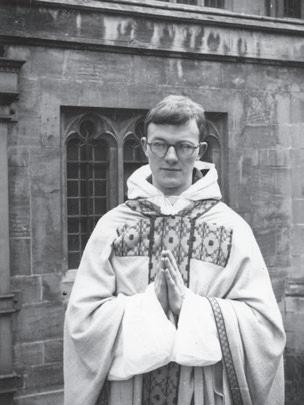
Father Julian served as director of admission for a time.
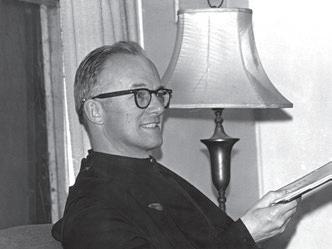
Fr. Julian did possess a good sense of humor, and his jokes and humorous comments were memorable. When Jamie MacGuire ’70 entered the School in September of 1966, he was assigned to Father Julian’s section of Latin A. “I rather doubt I increased his pleasure in teaching by jumping out a classroom window in the old Barn with my friend Michael Gay while Julian was facing the blackboard one especially hot and airless September morning,” he recollects. “Father Julian’s comment on my report card at the end of that term was (truly, alas), ‘Only the occasional yawn would reassure me he had not fallen asleep altogether.’”
Phil English ’74 recalls those days as well, “I always relied on him as a witness. I knew if anyone ever accused me of Latin, DJ could cheerfully testify in any court to my innocence.”
Another example of Fr. Julian’s drollery, Jamie MacGuire remembers, was when he was first given a tour of the old Farm after it had been leased by Peter de Savary and transformed into a high-priced, destination golf club. “Where do we go to take our vow of affluence?” Julian asked.
Father Julian produced several books: the translation of The Mystagogia of St. Maximus the Confessor; his book of poems, There Shines Forth Christ; and his book on the Benedictine Rule, St. Benedict, A Rule for Beginners. In addition, he co-wrote a selfhelp book called Love-Ability, with Madeline Pecora Nugent. Father Julian also played a key role in making sure the literary papers and other ephemera of William Force Stead were properly collected and preserved. These include W.F. Stead’s own poetry as well as an important treasure trove of secondary material on the lives, art, and private doings of some of the greatest Irish and English poets including T.S. Eliot, John Keats, and Percy Bysshe Shelley, now housed and available for study at the Beinecke Rare Book Library at Yale University.
Of Father Julian’s many friends, a good number of them looked to him for help and encouragement in leading the Christian life. He gave what he could simply and generously. Included in his life-long friendships were Tom Howard, Peter Kreeft, Tracy Kidder, Benedict Fitzgerald and a prodigious list of Catholic intellectuals and artists with whom he corresponded throughout his life.
Author Rosaria Munda ’10 was one of those alumni who was profoundly impacted by Father Julian and maintained a friendship beyond the Abbey. “I was fourteen when I first met Fr. Julian, a titanic figure with a soft British accent whom I’d press for stories after House Mass about his childhood, having tea with C.S. Lewis and T.S. Eliot,” she recalls.
“Fr. Julian was a kind man, a poet, an artist. He was a link to the gilded past of the Inklings and Oxford Catholicism, to the elusive idea of a faith that merged with poetry and found God in beauty. He didn’t just remember that world; he believed in it and had a gift for bringing it to life for others (or for me, at least). He told me once that he read the Narnia books meditatively, to pray by; sent me typed letters explaining intricate bits of theology woven in with anecdotes about Lewis; and
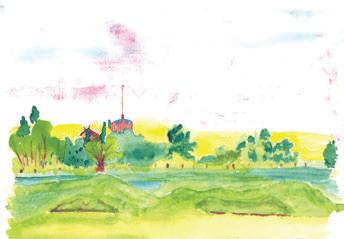
Father Julian’s watercolor of the Abbey church and fields
we kept up correspondence as I studied at Worcester College, Oxford, where his father had chaplained. He sent me a painting of the bridge of Clifton Hampden, his childhood village, and I visited it. It was one of the most beautiful places I saw in England – flooded and at dusk.
“In our last conversation, when he no longer remembered me, Fr. Julian expressed frustration that he was in a nursing home rather than at his Abbey – where he had studied, and then lived as a monk, since he was fourteen. I hope he came to be at peace with his final home in late life, and that he died peacefully, happily, and glad to go with God. I am grateful for the years his life graced mine.”
Father Julian once told Jamie MacGuire ’70, “I was sent to boarding school at two-and-a-half years old. When I was 10, there was a monk at Worth named Father Nicholaus, whom we called “Nicko” behind his back. One day he said, “The Christian life is hard, I know, and if I could help just one of you to try to live a Christian life, then I would feel I had succeeded. My spontaneous response was, ‘I want to be that one.’ And I have thought of that moment every day of my life since, and it I has sustained me, strange though it may seem. So you just never know.”
Adam Carter ’83, upon hearing of Father Julian’s passing, shared that Father Julian was one of the last surviving grandchildren of a Washington, D.C. architect named William Stead who left a bequest to the District that a playground for the children of D.C. be founded and named in honor of his late first wife, Mary Force Stead. Father Julian called Adam’s dad for help in untangling the City’s poor handling of the money and the bequest. With many years of work and perseverance and great help from alumni Outerbridge Horsey ’71 and Chris Dorment ’63 and many others, the Friends of Stead Park was founded. Property that was being held in trust in a previously unheralded part of town was located. When sold, it turned out to be near the new Nationals Stadium, thus worth a lot more than it had been before baseball announced its return to D.C. The Stead Trust was suddenly imbued with substantial resources. The park located at P Street NW between 16th and 17th Streets, NW is now known as Stead Park and is due to have a $15 million upgrade over the next two years or so. “This is a really great example of a public-private partnership and a net-zero indoor-outdoor space – for the benefit of the Children of the District of Columbia,” says Adam. The Stead name will live on in this most excellent way.”
Father Julian lived the final years of his life away from his monastery, in nursing homes in East Greenwich and Newport, Rhode Island. While he struggled with this separation from the Abbey, he nevertheless made himself fully available to these his penultimate communities. Tony Caputi ’74 would visit him there often, recently recalling: “He held court like he was the mayor and naturally settled into the role of cheering people up. He continued his passion for watercolors and had access to TV. Mostly EWTN, not Kardashians. And, of course, he could watch his beloved Baltimore Orioles instead of listening to a scratchy AM radio, while wearing his prized team jersey.” Dr. Blake Billings ’77 notes, “Remaining active in painting, bikeriding, reading, research, writing, and hospitality, and ever persevering in prayer, Father Julian absorbed and exuded the Benedictine spirit – and this, he himself taught, was nothing more than the spirit of the gospel.”
Father Julian’s Requiem Mass was celebrated in the Portsmouth Abbey Church on December 30th, and he was bur-
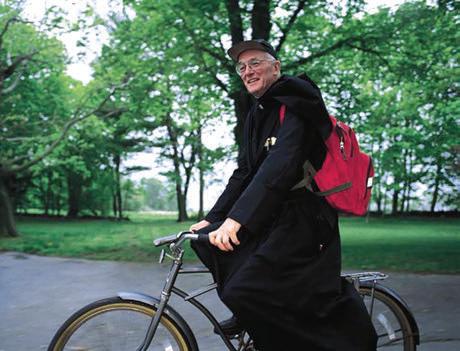
Father Julian at St. Clare-Newport

ied in the monastic cemetery thereafter. His passing marks the last living monastic link to the founder of the Portsmouth community in 1919, Dom Leonard Sargent, and also to Dom Hugh Diman, the legendary founder and first headmaster of Portsmouth Priory, now Abbey, School.
Prior Brunner concluded the service with, “Today Father Julian’s absence among us should provoke thoughts of gratitude for the 94 years he lived among us. We must be thankful for all that he gave us in that time and for all that he allowed us to give to him…. But Jesus Christ himself reassures us: Blessed…Happy…are they who mourn, for they shall be comforted. He also tells us: Happy are the merciful, for God will show them mercy. Happy are the pure of heart, for they shall see God. And those words apply to Father Julian. Father Julian prepared well for his passing from this world by living well, by living the Gospel which gave him a window into God’s wisdom he shared with us all. We have heard from many alumni of the school recounting his acts of kindness, his interest in their well-being and his impact as coach, teacher and priest on their lives.“
May he rest in the Light of Christ. “He enkindled in me a love of languages with two years of Greek in 1957-59. He was an excellent teacher and a most faithful Benedictine.” – R. Emmet Kennedy, Jr., ‘59
“He was a very talented artist (poet, painter, writer) from a family which included Chesterton, C.S. Lewis and Waugh amongst its social network. Julian was eccentric, shy, and caustic at times. He had a rich interior life which led to a deep union with the Lord.” – Chris Dorment ’63
“I always appreciated him over the last few reunions because of his acute memory and non-judgmentalism...he and I always had a mutual understanding of the importance of meditation and contemplation in one’s life....he is free at last of this mortal body, may he soar mightily in the sacred dimensions of Spirit.” – John Lamenzo ’63
“He was an enduring embodiment of peace and love. What a model human being.” – Rick Bevington ’71
“What a great soul and lasting friend in the many years since. A son of Maryland and an ardent Orioles fan to the end!” – Outerbridge Horsey ’71
“Before he went into the nursing home, we would go have lunch on occasion. He told me his early life ambitions were to either be a Marine or a prize fighter. Yet, he became a monk. DJ would sneak a cigarette now and then, knowing he shouldn’t, and it reminded me of our adolescence, between class smoking klatches on the down low. Cracked me up. I have a suspicion that, if he hadn’t become a monk, he could have been quite a rascal. He wasn’t the type of guy that held his personal piety above others. He knew he was fully human, flaws and all. His compassion was pure. Amen.” – Tony Caputi ’74
“He was a gentle and saintly man. Father Julian made an enormous contribution to the spiritual community at Portsmouth. I always relied on him as a witness. I knew if anyone ever accused me of Latin, DJ could cheerfully testify in any court to my innocence. “ – Philip English ’74
“Our beloved Dom Julian left our world for his well-deserved place in heaven… all of us were in his prayers and the beneficiaries of his love, faith and work.” – Carroll Carter, Jr.’77
“Father Julian was a warm and gentle presence whose smile endures in my memory.” – Ignatius MacLellan ’77
DANIEL T. BUD KELLY, JR. ’39
“Bud” Kelly, Jr., a luminous man with a prodigious historical memory who was recognized as one of Santa Fe’s Living Treasures, passed away on August 18, 2020 at age 99. Bud was a native Santa Fean, born to an historically significant family, who in turn built upon that legacy and commitment to civic responsibility in his own right by not only serving his country in WWII and Korea but by returning to Santa Fe to help establish and grow many of the city’s newer institutions.
Bud was the son of Margaret Gross and Daniel T. Kelly, Sr., president of Gross, Kelly & Company, a pioneering wholesale and retail mercantile company synonymous with the development of the Southwest, which first arrived on the scene in Las Vegas, NM, in 1879. The company operated ranches throughout New Mexico, including a 40,000-acre cattle ranch straddling San Miguel and Guadalupe Counties. It was growing up in that country, accompanying his father on business trips, that Bud fell in love with New Mexico, meeting merchants and traders and learning to rope and ride from cowboys working the ranches. He would also, in due course, come to learn the business side of things, involved as Gross Kelly was with trading posts and the wool and timber industry.
Margaret was no less a formative presence in Bud’s life than was Daniel, as she ensured her children had proper religious training and cultural exposure. It was through gatherings at their home that Bud was first introduced to many local luminaries; Oliver LaFarge, Witter Bynner, Peggy Pond Church, John G. Meem, and Mable D. Luhan. This breadth of exposure were key ingredients to Bud’s unique character.
Schooling took Bud to Portsmouth Priory at age 13 for five years, and then on to Harvard where he graduated in 1943. During WWII, he was commissioned as a Second Lieutenant in the Army Field artillery and assigned to the Anti-submarine Command in Brittany, France, where he earned a Bronze Star.
After the war, Bud worked for General Mark Clark at the Quadripartite Council Meetings in Vienna, where he experienced the more glamorous side of military life; as an aide he often stood in for the generals during meetings and social events. Each filled him with stories he would tell across his lifetime: of losing most his unit to a torpedo when crossing the Channel, of collecting money and heading out across unsecured territory to chase down liquor for his comrades, or dancing in glorious ballrooms in formal attire. Bud returned to the family business in Santa Fe in 1948 after earning his MBA at Harvard. But soon warfare in Korea erupted, and Bud was assigned to the I Corps Artillery as a captain, later promoted to major. Following the war Bud returned to Santa Fe, working as president of Gross Kelly until 1954. The liquidation of Gross Kelly coincided with his marriage to the beautiful and cultured Jeanne Wise from New York. Bud and Jeanne raised two sons and two daughters.
Bud also engaged in a new business enterprise when he partnered with the Howell Ernest Insurance Company in 1957. Acquiring full ownership in 1965, he would remain at the helm of the Kelly Agency until his retirement. His work brought him again into contact with local luminaries with whom he formed lasting friendships: Ernie Blake of Taos Ski Valley, John Crosby of the Santa Fe Opera, the painter Georgia O’Keefe, to name a few. Bud became an active member of the Santa Fe business community and a founding board member for St. John’s College, Santa Fe Prep, and the Santa Fe Opera. He was also a director of the First National Bank and president of the School of American Research.
His love of the outdoors led to his passionate participation in the Pajarito Walking Group, Santa Fe Winter Ski Club, and his beloved Kiva Squash Club. Bud could also be found throughout the year tending to his 128-acre “sanctuary” in the Santa Fe National Forest. Bud was a man for all seasons, whom people in Santa Fe would recognize on the street with his Stetson Open Road, a Brooks Brothers tweed jacket, button down shirt accented by an ascot, wool slacks, cowboy boots, and in later years a cane.
He was the embodiment of the great sweep of New Mexico history and lore, a gentleman cowboy, and community builder. He was also simply and profoundly human: he had a passionate curiosity mixed with a fiery temper, he was a devout man and incessant flirt, he was a fastidious man who lacked attachments to material things.
It was that mix of those contradictions, which made him the fully formed character he was. Son to Daniel and Margaret, father to sons and daughters, husband to Jeanne, and spirit to friends and the generations that follow, Bud Kelly honored his family heritage and left a lasting legacy for all of Santa Fe.
The Portmsouth Abbey community offers its prayers and deepest condolences to the Kelly family.










